Igbo Architecture | Ụlọ omé n'Ìgbò - Culture (2) - Nairaland
Nairaland Forum / Nairaland / General / Culture / Igbo Architecture | Ụlọ omé n'Ìgbò (130650 Views)
Indigenous Hausa Tubali Architecture / The Art And Architecture Of Yorubaland! / Benin Art And Architecture (2) (3) (4)
(1) (2) (3) (4) (5) (6) (7) (8) (9) (10) ... (12) (Reply) (Go Down)
| Re: Igbo Architecture | Ụlọ omé n'Ìgbò by ezeagu(m): 5:47pm On Aug 01, 2012 |
Gone to sig. |
| Re: Igbo Architecture | Ụlọ omé n'Ìgbò by ezeagu(m): 6:11pm On Aug 01, 2012 |
Anambra door into a walled compound. 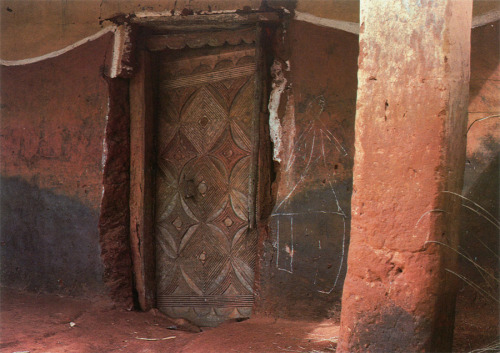 "Portal with decorated door, Nimo." |
| Re: Igbo Architecture | Ụlọ omé n'Ìgbò by ezeagu(m): 6:14pm On Aug 01, 2012 |
Nri Kingdom Eze Obalike sounds his bell. I believe this is the eze before the king before the present king, he was the last king of independent Nri.  "The Kingdom of Nri (948—1911) was the West African medieval state of the Nri-Igbo, a subgroup of the Igbo people, and is the oldest kingdom in Nigeria. The Kingdom of Nri was unusual in the history of world government in that its leader exercised no military power over his subjects. The kingdom existed as a sphere of religious and political influence over much of Igboland, and was administered by a priest-king called the eze Nri. The eze Nri managed trade and diplomacy on behalf of the Igbo people, and possessed divine authority in religious matters.The kingdom was a safe haven for all those who had been rejected in their communities and also a place where slaves were set free from their bondage. Nri expanded through converts gaining neighboring communities’ allegiance, not by force. Nri’s royal founder, Eri, is said to be a ‘sky being’ that came down to earth and then established civilization. One of the better-known remnants of the Nri civilization is its art, as manifested in the Igbo Ukwu bronze items.Nri’s culture had permanently influenced all of Igbo culture, especially through religion and taboos. It brought new advanced concepts of the creator, Chineke, and of the universe in general. British colonialism, as well as the Atlantic slave trade, contributed to the decline of the Nri Kingdom. The Nri Kingdom is presently going through a cultural revival. Picture: Nri Kingdom Eze Obalike sounds his bell. Picture Source here." 1 Like |
| Re: Igbo Architecture | Ụlọ omé n'Ìgbò by ezeagu(m): 8:43pm On Aug 01, 2012 |
Ebonyi/Abia State.  "Nkamalo shrine inside Ezi Akputa compound, Mgbom village, Afikpo Village-Group, Nigeria. — Simon Ottenberg, 1951-1953." |
| Re: Igbo Architecture | Ụlọ omé n'Ìgbò by ezeagu(m): 8:44pm On Aug 01, 2012 |
Ebonyi/Abia State side again. 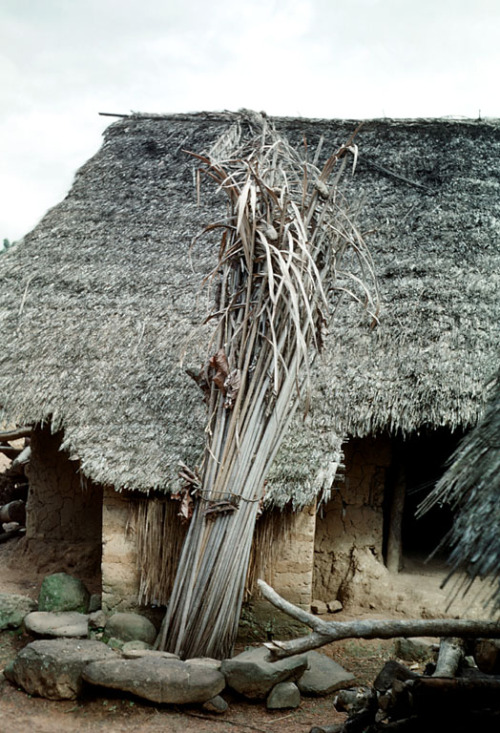 "Ibini okpabe shrine in front of the Nsi omomo shrine, in Ezi Akputa compound, Mgbom village, Afikpo Village-Group, Nigeria. “Religion plays an important role at Afikpo in almost every sphere of life. Everywhere there are shrines to humanlike and nonhuman supernatural forces. Often they are placed at the base of a tree, in a group of natural rocks or specifically constructed rock platforms, or in a shrine house, or are found at farms, along paths, in the commons of villages, in the compounds, sometimes even inside dwelling places. The shrines symbolize the diversity of beliefs, rituals, and history in the village group. Ward elders perform sacrifices at shrines for which the ward executive grade provides much of the sacrificial materials. One commonly found shrine, Ibini okpabe, to the Aro Chuku oracle, is located outside of the ward resthouse. It usually has no priest, a thank offering being given it by an interested elder at the New Yam Festival and at other times on the suggestion of a diviner. Another important major patrilineal shrine is Nsi omomo (medicine-birth), primarly for fertility, but also concerned with general welfare. The shrine is for the whole lineage. The controlling group selects the priest, who may also be the ancestral shrine priest, in the usual manner.” [Ottenberg S., 1968: Double Descent in an African Society; the Afikpo Village-Group. University of Washington Press]. — Simon Ottenberg, 1951-1953." |
| Re: Igbo Architecture | Ụlọ omé n'Ìgbò by ezeagu(m): 8:47pm On Aug 01, 2012 |
Arochukwu, Abia State. They seem to have had many storey buildings.  "House of Chief Ezuma-Kanu-Eni. [Arochukwu Amankwu]. — Zbigniew Dmochowski, Introduction to Nigerian Traditional Architecture: South Eastern Nigeria v. 3." |
| Re: Igbo Architecture | Ụlọ omé n'Ìgbò by ezeagu(m): 8:49pm On Aug 01, 2012 |
An Igbo pyramid. Enugu State. [img]http://mccoy.lib.siu.edu/jmccall/jones/igbo/arunsi11.JPG[/img] I think this is from Nsude and was used as a shrine. Maybe missionaries convinced them to destroy them or maybe they're still there. |
| Re: Igbo Architecture | Ụlọ omé n'Ìgbò by ezeagu(m): 8:50pm On Aug 01, 2012 |
Asaga Ohafia, what is now in Abia State. [img]http://mccoy.lib.siu.edu/jmccall/jones/igbo/asaga1.JPG[/img] Statues in an Obu. G. I. Jones. |
| Re: Igbo Architecture | Ụlọ omé n'Ìgbò by ezeagu(m): 8:54pm On Aug 01, 2012 |
More parts of the Obu in Ohafia. [img]http://mccoy.lib.siu.edu/jmccall/jones/igbo/asaga5.JPG[/img] The images may be some idols or ancestral figures, the painting may be uri, but there are too many types of symbols, especially in the Cross River region, to be definite. The roof seems to be constructed with bamboo beams and seems quite strong, the rest is mud and wood. |
| Re: Igbo Architecture | Ụlọ omé n'Ìgbò by ezeagu(m): 8:57pm On Aug 01, 2012 |
Well carved door or screen from Oka in the 70s but probably much older. The northern part of Igboland seemed to have had good door manufacturers as seen from the buildings originating in those regions.  "Obu Shrine with Azu Oji backdrop. Awka, July 1978" |
| Re: Igbo Architecture | Ụlọ omé n'Ìgbò by ezeagu(m): 9:02pm On Aug 01, 2012 |
Abiriba obu meeting house. This seems to be an ekpe lodge which odumchi earlier explained. [img]http://mccoy.lib.siu.edu/jmccall/jones/igbo/abiriba30.JPG[/img] "Carved pillars in Obu house Abiriba. Jones notes: 'Figures carved on the central pillar are: below, a woman with a waterpot on her head; above, an "Egbo runner" (i.e. the agent of the Ekpe [Egbo] secret society, his identity concealed beneath a tight fitting all enveloping costume and believed by the uninitiated to be a forest daemon. The servant of the Ekpe spirit to which the society ministers.)" |
| Re: Igbo Architecture | Ụlọ omé n'Ìgbò by ezeagu(m): 10:22pm On Aug 01, 2012 |
Unknown origin. [From somewhere noted as Ihale by J Stöcker between 1880-1939] 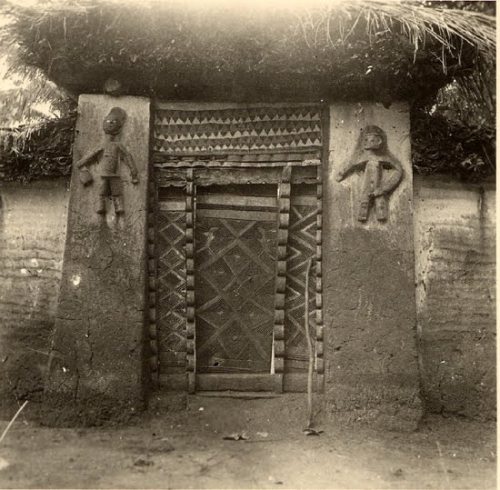 [img]http://3.bp..com/-Xot6-1ZvXy4/Tqdtt6oqikI/AAAAAAAAAvw/d1iv-lf0fOY/s1600/door.jpg[/img] A gate to a walled compound with a carved door and panels, two pillars with carved figures on them. |
| Re: Igbo Architecture | Ụlọ omé n'Ìgbò by ezeagu(m): 10:26pm On Aug 01, 2012 |
Gone. 1 Like |
| Re: Igbo Architecture | Ụlọ omé n'Ìgbò by oturugo(m): 11:00pm On Aug 01, 2012 |
@Ezeagu, good job, proud Anioma son. 2 Likes |
| Re: Igbo Architecture | Ụlọ omé n'Ìgbò by ezeagu(m): 12:01am On Aug 02, 2012 |
Igbo house of unknown origin. 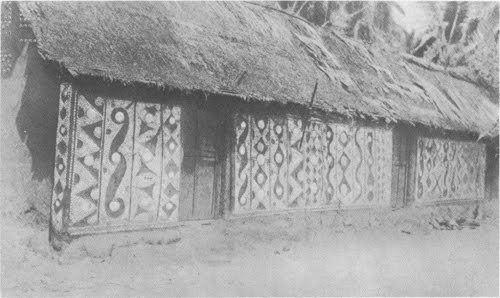 Painted wood panels on mud walls. |
| Re: Igbo Architecture | Ụlọ omé n'Ìgbò by ezeagu(m): 12:03am On Aug 02, 2012 |
Owere area again. Mbari building. Oratta Igbo.  "Mbari to Eketa in Umueke Ihitte. Done by an artist known as Ugo." 2 Likes |
| Re: Igbo Architecture | Ụlọ omé n'Ìgbò by ezeagu(m): 12:04am On Aug 02, 2012 |
Anambra region, the walls are painted with uli, sort of looks like a galaxy. 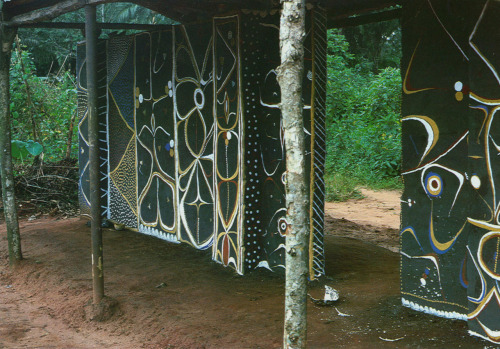 "Painted Entry wall of communal shrine. Nimo" |
| Re: Igbo Architecture | Ụlọ omé n'Ìgbò by ezeagu(m): 12:26am On Aug 02, 2012 |
More from Imo State. Oratta Igbo.  "Mbari for Obiala in Ndiama Obube by Nnaji." |
| Re: Igbo Architecture | Ụlọ omé n'Ìgbò by ezeagu(m): 12:33am On Aug 02, 2012 |
Decorated building. Quite simple compared to the other buildings posted.  "Mural by Helen Obiora, Orno, 1995. Photo: Sarah Adams, 1995. — Sarah Adams" |
| Re: Igbo Architecture | Ụlọ omé n'Ìgbò by ezeagu(m): 12:36am On Aug 02, 2012 |
More Mbari from Imo State. Oratta Igbo. 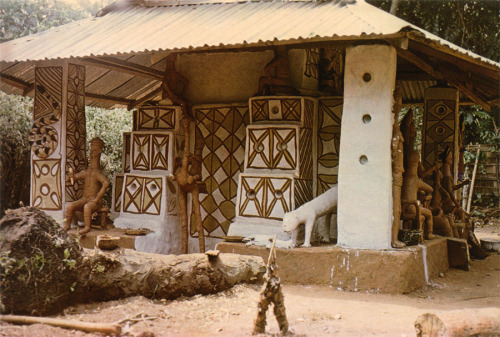 "[PIC 1] IN THE FOREGROUND IS THE “UGLY CHILD,” THE FIRST FIGURE MODELED. NEITHER IN THE MBARI NOR FINISHED, IT IS A SCAPEGOAT TO DRAW OFF ANY EVIL INFLUENCES." 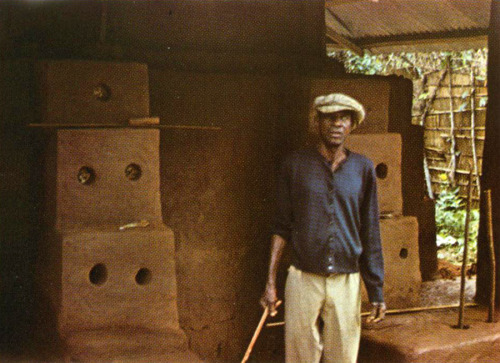 "[PIC 2] AKAKPORO, THE ARCHITECT AND PRINCIPAL SCULPTOR OF THE MBARI TO ALA IN NNORIE, STANDS BEFORE THE MBARI CORE BUILDING. THE PLATES HAVE BEEN INSERTED." |
| Re: Igbo Architecture | Ụlọ omé n'Ìgbò by ChinenyeN(m): 1:06am On Aug 02, 2012 |
Why am I not surprised by the academia's lack of information on the Asa-Ndoki-Ngwa-Ohuhu axis? |
| Re: Igbo Architecture | Ụlọ omé n'Ìgbò by ezeagu(m): 1:46am On Aug 02, 2012 |
I don't know, the same can be said for some other areas. They are almost completely ignored. Maybe they assume the areas they touch are enough to estimate the other related groups. The closest traditions to Ngwa or anywhere in Umuahia that are touched on here is Bende, Ohafia and Arochukwu. ----------- Nri-Oka (again)  The corrugated metal roof is obviously new/post-colonial. Igbo Carved Doors Nancy C. Neaher African Arts, Vol. 15, No. 1 (Nov., 1981), pp. 49-55+88 |
| Re: Igbo Architecture | Ụlọ omé n'Ìgbò by ezeagu(m): 2:00am On Aug 02, 2012 |
ChinenyeN: Why am I not surprised by the academia's lack of information on the Asa-Ndoki-Ngwa-Ohuhu axis? I think G. I. Jones information is more balanced. |
| Re: Igbo Architecture | Ụlọ omé n'Ìgbò by ezeagu(m): 2:07am On Aug 02, 2012 |
[img]http://2.bp..com/-v6h-VHOw9Ug/TqScmx5sXlI/AAAAAAAAAss/8FSLDUat0Kk/s1600/AN00052708_001_l.jpg[/img] [img]http://3.bp..com/-rWQSx5k4PCU/TqSb839NlEI/AAAAAAAAAr8/XbS6cJ5VD0c/s1600/AN00053800_001_l.jpg[/img] Edward Rowland Chadwick, 1927-1943. |
| Re: Igbo Architecture | Ụlọ omé n'Ìgbò by ezeagu(m): 2:11am On Aug 02, 2012 |
Mbari interior [img]http://1.bp..com/-lyImXVLDYns/TqSaC8L34ZI/AAAAAAAAAqA/ifVKz6V3awo/s1600/AN00053440_001_l.jpg[/img] [img]http://2.bp..com/-vbWT6zF2Mfw/TqSaCt-FtBI/AAAAAAAAAp4/-zl-3A06ZiY/s1600/AN00053790_001_l.jpg[/img] [img]http://4.bp..com/-6QthBbjxMIc/TqSaCvuvy9I/AAAAAAAAAps/1fX6GQonXeI/s1600/AN00053789_001_l.jpg[/img] Edward Rowland Chadwick, 1927-1943. |
| Re: Igbo Architecture | Ụlọ omé n'Ìgbò by ChinenyeN(m): 2:30am On Aug 02, 2012 |
ezeagu: I think G. I. Jones information is more balanced.Do you have access to Jones' full text? |
| Re: Igbo Architecture | Ụlọ omé n'Ìgbò by odumchi: 3:11am On Aug 02, 2012 |
I was unable to find a decent photo of an ekpe lodge so I decided to illustrate one myself. Sorry for the crudeness, lol. This is supposed to be a 19th century lodge. Around the 30s, people began using zinc and stone to build these lodges instead of the traditional mud and grass. 4 Likes
|
| Re: Igbo Architecture | Ụlọ omé n'Ìgbò by ezeagu(m): 3:31am On Aug 02, 2012 |
ChinenyeN: I mean't overall, since he has many years of researching Igbo culture. The only text I have is not online. He seemed to be the few that concentrated more on the south, like Ekpe in Umuahia. http://mccoy.lib.siu.edu/jmccall/jones/ekpe.html odumchi: I was unable to find a decent photo of an ekpe lodge so I decided to illustrate one myself. Sorry for the crudeness, lol. Good drawing. I think I posted an Egbo meeting house from Abiriba above. |
| Re: Igbo Architecture | Ụlọ omé n'Ìgbò by odumchi: 5:48am On Aug 02, 2012 |
ezeagu: Thanks. Ah, you're right. I'll look at the Abiriba one. |
| Re: Igbo Architecture | Ụlọ omé n'Ìgbò by ChinenyeN(m): 8:06am On Aug 02, 2012 |
ezeagu: I mean't overall, since he has many years of researching Igbo culture. The only text I have is not online. He seemed to be the few that concentrated more on the south, like Ekpe in Umuahia.I see. Thank you. By the way, which text do you have exactly, if I may ask? |
| Re: Igbo Architecture | Ụlọ omé n'Ìgbò by Abagworo(m): 9:56am On Aug 02, 2012 |
ezeagu: Some figures in Owere associated Mbari 'houses' or temples. People have almost killed the Oratta group of Igbos by calling them Owerri and sometimes adding some Isu groups like Mbieri to Owerri. Always specify if its Oratta or Isu as Owerri is a boundary of Oratta and Isuama Igbos. Not to derail the thread but help in specifying the accuracy of labels. |
| Re: Igbo Architecture | Ụlọ omé n'Ìgbò by ezeagu(m): 3:22pm On Aug 02, 2012 |
ChinenyeN: Ibo Art, 1989. Shire Ethnography. Abagworo: People have almost killed the Oratta group of Igbos by calling them Owerri and sometimes adding some Isu groups like Mbieri to Owerri. Always specify if its Oratta or Isu as Owerri is a boundary of Oratta and Isuama Igbos. Not to derail the thread but help in specifying the accuracy of labels. Notice I kept writing 'Owere area'. The source of the pictures didn't specify Mbari to be part of Oratta culture, only around Owere. I was labelling the architecture by the general regions people may be familiar with, like how I wrote Nri-Oka for the buildings found in Anambra. I'll change the labels. |
(1) (2) (3) (4) (5) (6) (7) (8) (9) (10) ... (12) (Reply)
A List Of Igbo Dialects And Where Their Speakers Are Found. / Ethiopia-the Birth Of Nations-the Origin Of The Green, Yellow And Red Flag! / Words From The Epie Language Of Yenagoa.
(Go Up)
| Sections: politics (1) business autos (1) jobs (1) career education (1) romance computers phones travel sports fashion health religion celebs tv-movies music-radio literature webmasters programming techmarket Links: (1) (2) (3) (4) (5) (6) (7) (8) (9) (10) Nairaland - Copyright © 2005 - 2025 Oluwaseun Osewa. All rights reserved. See How To Advertise. 43 |
